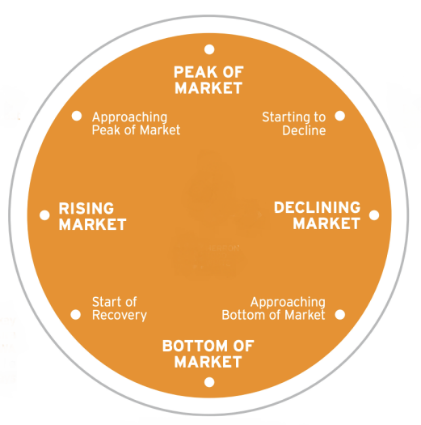Warren Buffet has just two rules that investors must follow to ensure success. His first rule is Never lose money and the second is Never forget the first rule. So how can investors use this wisdom to profit in the current market?
It would seem that getting into a growth market is the best way to avoid losing money, and in fact many investors do just that, by holding off buying properties until they are sure that prices are rising.
There’s an issue with buying in growth markets
 The issue is that property market performance in a city, region or even a suburb moves in a recurring pattern of growth and decline, as the picture shows.
The issue is that property market performance in a city, region or even a suburb moves in a recurring pattern of growth and decline, as the picture shows.
When we are in a growth phase such as the current one, it’s critical to know just how long prices are likely to keep rising. Are we still at the beginning, with more good growth to come, or are we already near the end? This is because sooner or later, prices will become unaffordable, or current buyer demand will be met and growth will end.
When growth ends, markets go into decline and eventually bottom out, sometimes for years, before demand grows again. It’s those investors who enter a market when prices are about to increase who make the most money.
On the other hand, the last buyers to enter a market before prices peak stand to lose, because they have purchased just before the declines set in.

So how do you know that the market where you intend to purchase an investment property has plenty of growth potential left in the tank? The answer to this is not measured by the length of time that price growth has been occurring, nor is it indicated by the amount of growth that has taken place. The answer is revealed by the types of buyers creating the demand.
Different types of buyers create different types of demand
Property buyers come in different groups, such as first home buyers, upgraders, downsizers and investors. Each of these has different motives and limits when it comes to buying property, so if we know which group is doing most of the buying, we can estimate when the growth is likely to end. And if we correctly forecast which group is likely to be next, we can buy just before the growth really kicks in.
Investors for example, are motivated only by profit. They enter markets when prices are rising and the more that prices rise, the more investors want to buy.
On the other hand, owner-occupiers are motivated by affordability. They enter markets when borrowing conditions are easy and finance costs are low. The more that prices rise, the fewer of them can afford to buy. Then, when the new affordability ceilings have been reached, owner-occupier demand slows and price growth stops.
In the current market, most buyer demand is being generated by owner-occupiers, not investors. Although that means there’s a limit to the growth that can occur, it also means that investors can take advantage by buying property in areas that have not yet experienced growth, but have the potential to.
Where to wait and where to jump in
As new affordability ceilings are reached, growth in first home buyer suburbs will slow down and then ripple to more affluent areas as upgraders take advantage of their increased equity and favourable borrowing conditions. This means that suburbs in well-established, desirable locations are highly likely to be next to rise in price as upgraders move and improve, indicated in these examples for Sydney and Melbourne.
Not only will many potential upgraders living in outer first home buyer suburbs move to better homes, but they will also relocate to more suitable suburbs. Investors who buy well-appointed, low maintenance properties in locations with excellent transport, recreational and retail services will be following Warren Buffet’s first rule - Never lose money, as they sit back and watch the price surge occur.
.................................................
 John Lindeman is widely respected as one of Australia's leading property market analysts, authors and commentators.
John Lindeman is widely respected as one of Australia's leading property market analysts, authors and commentators.
Visit Lindeman Reports for more information.
He has well over fifteen years’ experience researching the nature and dynamics of the housing market at major data analysts.
John’s monthly column on housing market research featured in Australian Property Investor Magazine for over five years. He is a regular contributor to Your Investment Property Magazine and other property investment publications and e-newsletters such as Kevin Turners Real Estate Talk, Michael Yardney’s Property Update and Alan Kohler’s Eureka Report.
John also authored the landmark books for property investors, Mastering the Australian Housing Market, and Unlocking the Property Market, both published by Wileys.
To read more articles by John Lindeman, click here
Disclaimer: while due care is taken, the viewpoints expressed by contributors do not necessarily reflect the opinions of Your Investment Property.